The 2022 FIFA World Cup in Qatar will begin on November 21 and will last for about a month. This is the 22nd tournament to be held for the first time in the Arab world.
The International Football Federation (FIFA) recently announced that it will use semi-automatic offside technology with artificial intelligence camera lenses to assist referees in making offside decisions at the Qatar World Football Championship.
Lots of data will be used
On the football field, before the player of the attacking team makes the pass, the other players of the attacking team cannot get in front of the last player of the defending team, in case of violation, it is offside.
Behind the semi-automatic offside technology is an inertial measurement unit (IMU) built into the Al Rihla, the official ball of the Qatar World Cup. This IMU continuously transmits the position of the ball 500 times per second. Special tracking cameras under the stadium roof use machine learning and 29 data points from the players to track the ball.
When a player is offside, the new system automatically issues a warning by combining the data captured by the IMU and the surveillance camera, and sends it to the VAR room referees in the nearby control room, who will verify the data and let the referee know what decision to make.
Now it’s up to the referee to decide. FIFA claims the process can be created in seconds, meaning offside calls can be made faster and more accurately.
FIFA President Gianni Infantino said this technology is the result of 3 years of research and testing to provide the best experience for teams, players and fans. FIFA is proud of this technology and can’t wait to see its benefits at the Qatar World Cup. semi-automatic offside technique.
“Referees and assistant referees are still responsible for decisions on the pitch,” said Pierluigi Collina, President of FIFA Referee Board, who is well-known to the fans, in his press release. Humans, not “robots”, are responsible for the game.





